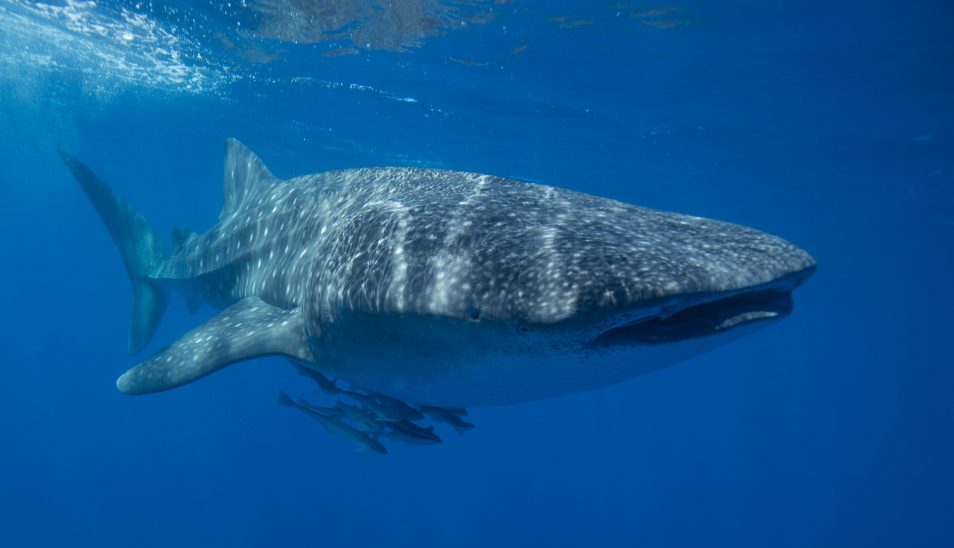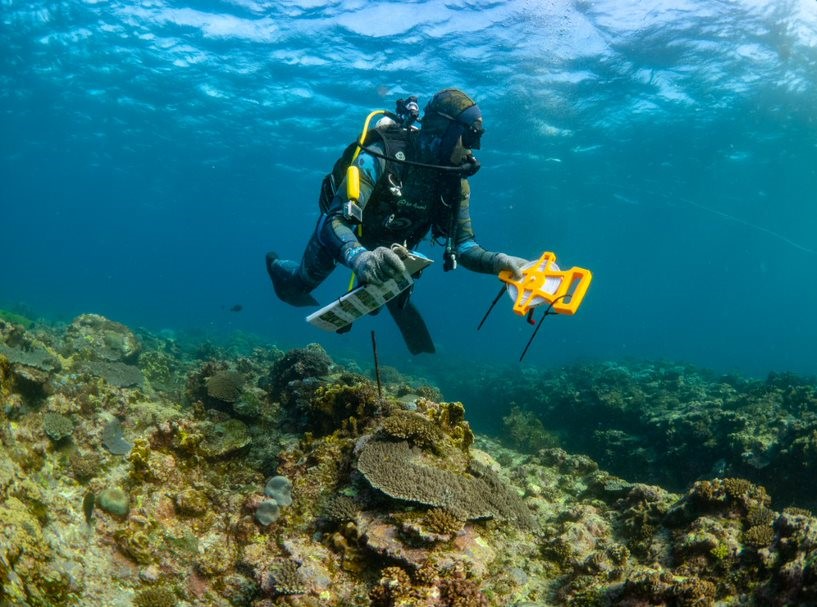
We reveal our top Ningaloo Reef discoveries. Like this one – using ultrasound and satellite tags has enabled our scientists to track the migration of nesting female turtles. Image: Dr. Richard Pillans
What do turtle nail clippings, diving whale sharks, and 12 million mushroom corals have in common?
They are all providing new and exciting insights into Ningaloo Reef, Western Australia.
This World Heritage Area is known to attract hundreds of thousands of visitors each year. And it’s no wonder. It’s home to incredible biodiversity including whale sharks, turtles and more than 200 species of corals and 500 fishes. Our science has revealed more about this unique ecosystem than ever before.
So, without further ado, here are our top Ningaloo Reef discoveries.
Turtle nail clippings and tracking
Our scientists have been able to track full nesting migrations of female green turtles.
Ultrasound of female turtles reveals if they have yolk-bearing follicles that will develop into eggs. Satellite tags enable us to track which beaches they go to and lay those eggs.
We tracked several green turtles from their feeding grounds at Ningaloo to nesting beaches hundreds of kilometres away, and back. This has rarely been done for any species of turtle anywhere in the world.
We also used turtle nail clippings, which grow at the end of their flippers, to reveal what turtles eat. Our scientists do this by analysing the chemical signatures of samples. We found what they eat varies according to how big they are (and so how old they are).
So what did we find? The diet of juvenile turtles on the reef is dominated by seagrass. But as turtles increase in size and move into lagoons and reefs, they feed on seaweed and jellyfish.

Twelve million mushroom corals have been discovered at Ningaloo Reef, the largest community believed to exist in the world. Image: CSIRO
Mushrooms of the coral kind, in the millions!
We have documented what is believed to be the largest aggregation of mushroom-shaped corals in the world. The 12-million strong community live at depths of about 40 metres along the shallow reefs of the Ningaloo coast. It is so dense, it’s the equivalent to half of Australia’s entire population standing shoulder to shoulder on Bondi Beach.
The corals, called Cycloseris distorta, are found in other parts of Australia and the world – including the Great Barrier Reef and the Galapagos Islands. But not as many as what has been discovered at Ningaloo Reef.
Like most corals, mushroom corals get their energy from the sun through single-celled algae that live within the corals and photosynthesise. They can’t survive in water that is too deep, because not enough light would reach them. Living in shallow water would expose them to rough sea conditions. The conditions at Ningaloo Reef are just right.

Whoa, it’s the biggest fish in the sea! We’re studying whale sharks to understand their movements and behaviours. Using their DNA will help us find out how many there are. Image: Dr. Richard Pillans
Making a splash with whale sharks
Whale sharks are the largest fish in the sea and can grow up to 16 metres. Last year, our scientists witnessed whale sharks attempting to mate. This was the first time this has ever been seen anywhere in the world.
Tracking the movement and behaviour of whale sharks is also providing other new insights. Most whale sharks remain within 300-400 kilometres of Ningaloo Reef. But we have recorded some individuals travelling thousands of kilometres, even as far as Indonesia. The speed at which they travel to ocean depths is much faster at night. Most likely because they are looking for their favourite food, plankton. They have been recorded swimming to a depth of 1.7 kilometres.
Using whale shark DNA will help us estimate how many whale sharks call Ningaloo Reef home.

We conducted extensive surveys of the shallow reefs and beaches of Ningaloo Reef, finding low levels of rubbish. Image: Ningaloo Outlook Shallow Reefs team
Keeping it clean
Ningaloo Reef is one of the cleanest reefs in the world. We swam along more than 45 kilometres of reef to survey corals, fishes and debris. We also walked more than 60 kilometres to count debris along the shoreline.
Our scientists found relatively little debris, with less than one item per hectare found on the reefs and less than 15 items per hectare found on Ningaloo’s beaches. Overall, the amount of debris the team found was much lower than similar coral reef ecosystems elsewhere in the world.
Ningaloo Reef discoveries: opportunities stem from real-world science
Our Ningaloo Outlook research is a collaboration with BHP that began in 2015. The partnership will continue for another five years until 2025, with a further $7 million co-investment to increase our knowledge of Ningaloo Reef.
Together with BHP, we will continue to bring real-world STEM activities to the community. Since 2015 we have engaged more than 1000 school students and local community group members to help us collect important data on turtles and reefs. They have helped us test new technologies so we can explore difficult to reach parts of the reef.
Ningaloo Outlook is critical for helping us track changes to Ningaloo Reef and supporting marine park management. We are providing vital information on trends and conditions, and insights into movement of iconic megafauna.
The next phase of this program will be starting this year to further increase our knowledge of this marine wonderland.


18th August 2020 at 8:11 pm
A partnership with BHP?! First question: What’s in it for them?
18th August 2020 at 3:38 am
Simplistic in the language used and you enticed further the reader with questions and not answers. However you gave no hint as to where the answers could be found
17th August 2020 at 11:13 pm
Very interesting. I find it terrific that the mineral resource and petroleum resource industry is providing financial support for these things. It is an interesting reflection on how society is changing where private enterprise as part of their social approach is replacing what used to be solely the gambit of Governments.